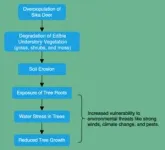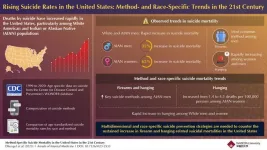(Press-News.org)
Fukuoka, Japan—Kyushu University researchers have found that Japanese beech (Fagus crenata) in the forests of southern Kyushu have seen reduced growth, due to soil erosion caused by the overpopulation of sika deer (Cervus nippon). Their findings, which were published in the journal Catena, could help in the development of new strategies for forest conservation.
Conservation is more than just preserving forests; it's about protecting the diverse web of life. One area where conservation has become critical is a beech forest in Shiiba Village, in the remote mountains of Southern Kyushu. The Japanese beech is a prominent and iconic species in Japan's cool-temperate forests, spanning all across Japan from Honshu to Southern Kyushu.
However, in recent years, the beech forest in Shiiba Village has been in decline, believed to be driven by the rapid growth of the sika deer population between the 1980s to the early 2000s.
"Due to their overpopulation and subsequent foraging, dwarf bamboo (Sasamorpha borealis)—the dominant understory vegetation in this area—was lost. This destabilized the soil and led to soil erosion, exposing the roots of the beech trees," explains Hayato Abe, a Ph.D. student in Kyushu University Forest, Graduate School of Agriculture and first author of the study. "We wanted to see if soil erosion was playing a role in the decline of the beech forest."
Abe and his team conducted an ecological survey on 12 beech trees at a research site in Shiiba Research Forest, established by Kyushu University in 1939. They investigated tree growth by measuring the production of leaves, stems, and roots. Tree ring samples were also obtained and used to compare the growth of the trees throughout the years. Their analysis revealed a concerning decline in tree growth since 1997 – around the same time that the understory vegetation was lost due to deer foraging.
Suspecting soil erosion as the primary driver for reduced tree growth, the team looked for a link by measuring the length of the exposed beech tree roots. They found that trees with more exposed roots showed lower growth rates and produced fewer new leaves.
To understand this link, the researchers also investigated how the trees use water. They found that trees that struggled to take up water were growing at a slower pace. A likely explanation, Abe says, is that the parts of the roots that remain in the soil retain water better, as they are exposed to less extreme temperatures. In contrast, the exposed roots are vulnerable to water loss due to freezing or drought and are unable to transport water efficiently.
"Our results suggest that soil erosion possibly leads to water stress in the trees, affecting their growth and health. These trees are also more vulnerable to damage from strong winds, climate change, and pests, which means they are also more likely to wither or die," says Abe.
The scientists also fear that due to fewer leaves growing, the leaf litter on the forest floor will also decrease, further exacerbating soil erosion and leading to a negative spiral. Ultimately, the study highlights the delicate relationship between forests and the wildlife that inhabit them, and the cascading impacts that occur when the ecosystem is out of balance.
"The Japanese government has been taking steps to reduce the local deer population. Up until the 1980s, the hunting tradition in Shiiba Village played a key role in controlling the sika deer population. But as time went on, the number of hunters decreased. Compounded by the lack of natural predators in the area, the deer population exploded, leading to the situation today," continues Abe. "The government is supporting local hunters but it's a short-term solution. They have also considered installing deer exclusion fences to restrict deer to a limited region. Unfortunately, due to the remoteness of Shiiba Village, setting up such facilities can be costly and time-consuming."
Solving problems in conservation is never an easy task and requires multifaceted and multidisciplinary approaches.
"As scientists, we can work to find the root causes of the problems and even develop solutions. But implementation will require working with other researchers and with the larger community," concludes Abe.
(By Negar Khalili)
###
For more information about this research, see "Soil erosion under forest hampers beech growth: Impacts of understory vegetation degradation by sika deer," Hayato Abe, Tomonori Kume, Fujio Hyodo, Mimori Oyamada, Ayumi Katayama, Catena https://doi.org/10.1016/j.catena.2023.107559
About Kyushu University
Kyushu University is one of Japan's leading research-oriented institutes of higher education since its founding in 1911. Home to around 19,000 students and 8,000 faculty and staff, Kyushu U's world-class research centers cover a wide range of study areas and research fields, from the humanities and arts to engineering and medical sciences. Its multiple campuses—including one of the largest in Japan—are located around Fukuoka City, a coastal metropolis on the southwestern Japanese island of Kyushu that is frequently ranked among the world's most livable cities and historically known as Japan's gateway to Asia. Through its Vision 2030, Kyushu U will 'Drive Social Change with Integrative Knowledge.' Its synergistic application of knowledge will encompass all of academia and solve issues in society while innovating new systems for a better future.
END
(SAN ANTONIO, TEXAS) — Mason Leist is working remotely—127 million light-years from Earth—on images of a supermassive black hole in his office at the UTSA Department of Physics and Astronomy.
The UTSA Graduate Research Assistant led a study, published in The Astronomical Journal, on the best method to improve images obtained by the James Webb Science Telescope (JWST) using a mathematical approach called deconvolution. He was tasked by the Galactic Activity, Torus, and Outflow Survey (GATOS), an international team of scientists, to enhance JWST observations of the galaxy NGC 5728.
The GATOS team, co-led by UTSA Professor and Leist’s doctoral ...
Lithium-ion batteries are a widely used class of rechargeable batteries in today’s world. One of the processes that can hamper the functioning of these batteries is an internal short circuit caused by direct contact between the cathode and anode (the conductors that complete the circuit within a battery). To avoid this, separators composed of polyolefins—a type of polymer— can be employed to maintain separation. However, these separators can melt at higher temperatures, and the inadequate absorption of electrolytes (essential for conveying ...
Are there specific communities that bear the brunt of suicide mortality? Certain studies have revealed that historically marginalized and economically deprived indigenous populations are linked with higher rates of cluster suicides—especially in Canada, the United States, and Australia. Public health officials need to consider that the risk of suicide contagion—social transmission due to insufficient interventions and resources—is real and must be countered. Now, a consortium of public health experts from Japan, Australia, and China have analyzed trends in suicide mortality in American Indian or Alaskan Native (AIAN) populations, while exploring ...
Perchlorates are a class of compounds that are notorious for their explosive nature. This raises safety concerns during experiments involving complex compounds that contain perchlorate ions, since explosions can be triggered even by the slightest shock or heat. It is, therefore, important to study their molecular structure and understand the reason behind their explosive nature.
In this context, a method called the Hirschfield surface analysis has been extensively used for visualizing and quantifying the crystal structure and molecular interactions of crystal compounds. Moreover, a two-dimensional fingerprint plot derived from the Hirschfield ...
DALLAS, Jan. 25, 2024 — This February, during American Heart Month and the American Heart Association’s Centennial year, the Association is devoted to a world of healthier lives for all by teaming up with retailers and brands around the country for Life is Why™, a cause marketing campaign supporting the Association’s life-saving heart and brain health mission. Life is Why inspires consumers to celebrate their reasons to live healthier, longer lives and participate personally in the mission of the Association by donating at the point-of-sale or by purchasing a product ...
PUYALLUP, Wash. — The pore-like structure of permeable pavements may help protect coho salmon by preventing tire wear particles and related contaminants from entering stormwater runoff, according to a Washington State University study.
Researchers demonstrated that four types of permeable pavements can act as giant filters, retaining more than 96% of applied tire particle mass. They also captured several tire-associated chemicals, resulting in a 68% average reduction of 6PPD-quinone, a contaminant shown to kill coho salmon in urban streams. The study findings were published in the journal Science of the Total Environment.
“The pressure on existing stormwater management technologies ...
Read all news releases on UAB’s peer-reviewed, published xenotransplant research and find media kits with video, photos, graphics and more at go.uab.edu/xenotransplant
The UAB News Studio is available for live or taped interviews with UAB experts.
BIRMINGHAM, Ala. – Currently used Food and Drug Administration-approved transplant drugs — with the addition of an also already FDA-approved complement inhibitor — are the optimal immunosuppression regimen for pig-to-human kidney transplants, according to a landmark discovery by University of Alabama at Birmingham investigators. The peer-reviewed research is published today in the Journal of Clinical Investigation.
“These ...
A call to include recommendations on low-sodium potassium-enriched salt in hypertension treatment guidelines has been made by an international group of experts today in the American Heart Association’s scientific journal Hypertension.
High levels of sodium intake and low levels of potassium intake are widespread, and both are linked to high blood pressure (hypertension) and greater risk of stroke, heart disease and premature death. Using a salt substitute where part of the sodium chloride is replaced with potassium chloride ...
New findings published in the journal Nature Neuroscience have shed light on a mysterious pathway between the reward center of the brain that is key to how we form habits, known as the basal ganglia, and another anatomically distinct region where nearly three-quarters of the brain’s neurons reside and assist in motor learning, known as the cerebellum.
Researchers say the connection between the two regions potentially changes our fundamental view of how the brain processes voluntary ...
According to a new paper in the Review of Economic Studies, published by Oxford University Press, the widespread adoption of work-from-home technology has had dramatic consequences for American life. Using an equilibrium model where people choose where to live and how to allocate their time between working at home and at the office, the researchers here find that the pandemic induced a substantial increase in the relative productivity of those working from home. This change has increased housing prices, reduced office rent costs, and will permanently ...





